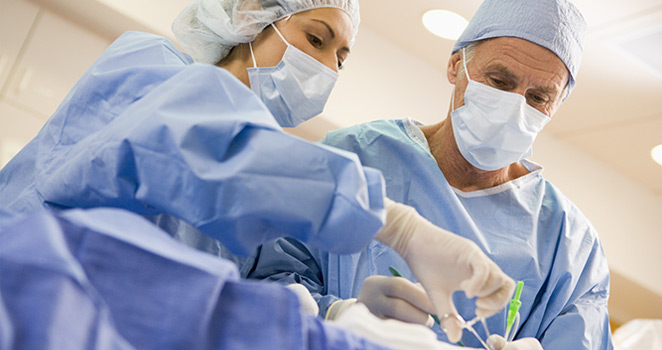Atrium Health Navicent Heart & Vascular Care
Coronary Bypass Surgery

What are Coronary Arteries?
Coronary arteries are the vessels that bring freshly oxygenated blood to the heart muscle. As we get older plaque can build up in these vessels and limit blood flow to the heart muscle. This can cause chest pain or a heart attack where a region of the heart does not function well.
Why do you need bypass surgery?
If someone has symptoms of chest pain or a heart attack they may see a cardiologist who would recommend a heart catheterization. This is when the cardiologist sticks a small needle in the groin or wrist and places a catheter at the origin of the coronary arteries and injects dye into the arteries. This allows us to see if the arteries are blocked. Sometimes the cardiologist will try to fix the blockages with a stent. If this can not be done they recommend coronary bypass surgery.
What is Coronary Bypass Surgery?
Coronary bypass surgery, often called cabg(cabbage), is when a surgeon reroutes blood around the blockages to get a fresh blood supply to the heart muscle. We no not remove the plaque in arteries.
What is Coronary Artery Bypass Surgery like?
Prior to surgery patients will be put under general anesthesia. This means they will be asleep and not feel pain. Once patients are sedated surgery can begin.
The surgeons will frequently harvest conduit from the patients leg to use for some of the bypasses. They will then divide the breastbone and harvest an artery or two from inside the chest to be used for other bypasses. Most of the time the surgeons will stop the patient's heart in order to have a clean and motionless field. This will require the heart-lung machine. The surgeons will then sew the conduits on the heart arteries distal to the blockage and sew the other side on the aorta proximal to the blockage. After the surgery the surgeon will close the breastbone and chest wall and place drainage tubes to remove any fluid that builds up around the heart or lungs.
What is recovery like after Coronary Bypass Surgery?
Patients should expect to stay in the hospital for about a 5 DAYS after aortic valve replacement, including up to three days in the intensive care unit (ICU).
Recovery after that depends on the age, health, and lifestyle of the patient. The period immediately after the procedure will require rest and limited activity, but a doctor may prescribe an exercise routine after a full recovery has been made.
Most people find they can return to their jobs after four to six weeks.
What Are the Risks of Coronary Artery Bypass?
As with all surgeries, aortic valve replacement comes with certain risks. These may include bleeding, blood clots, stroke, kidney failure, infection, and a medication reaction used in the surgery, and breathing problems.
Occasionally, a pacemaker might need to temporarily be installed if the rate and rhythms of the heartbeat are slowed significantly after the surgery.